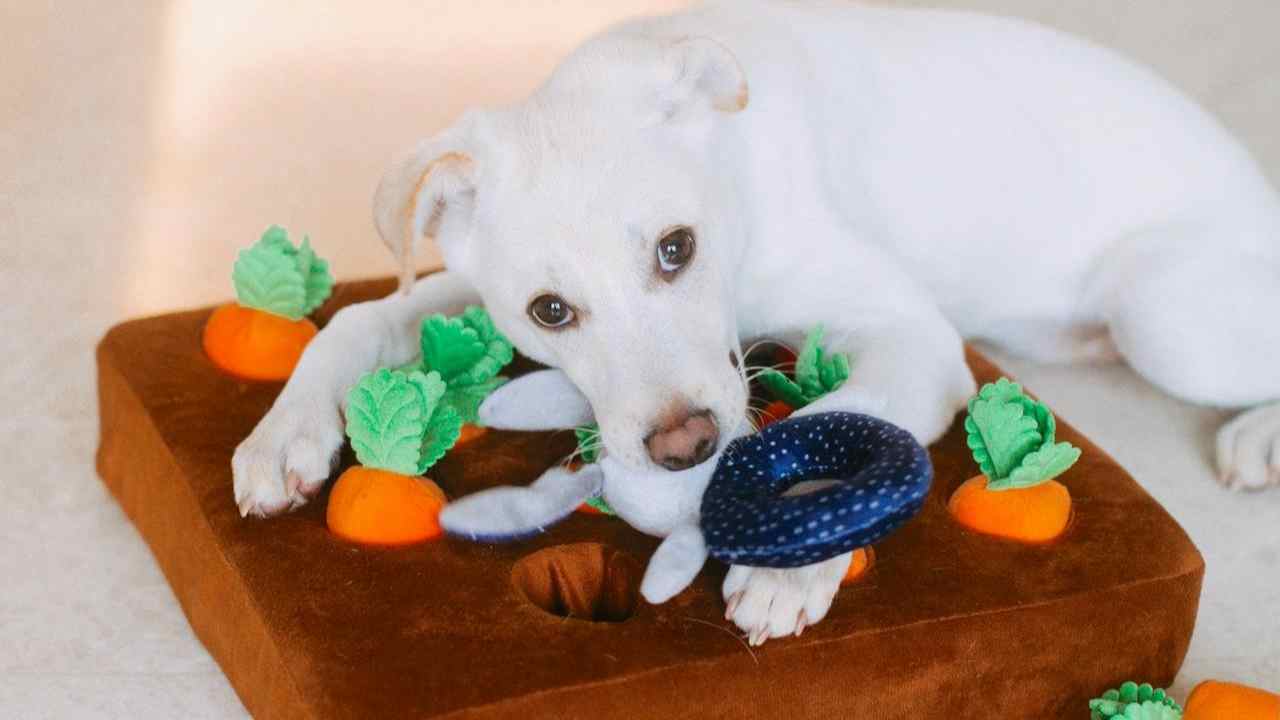Do you have two dogs with very different energy levels? It can be tough to keep both happy and engaged without feeling overwhelmed.
You want your high-energy dog to burn off that endless enthusiasm, while your calmer pup still gets the mental and physical stimulation they need. Designing enrichment routines that work for both might seem tricky, but it’s totally possible—and more rewarding than you think.
You’ll discover simple, practical ways to create activities that match each dog’s pace, so you can enjoy a peaceful, happy home where both tails keep wagging. Keep reading to find out how to make enrichment time a win-win for your furry friends.
Assessing Energy Levels
Understanding your dogs’ energy levels is key to designing effective enrichment routines. Each dog has unique needs based on their activity level. Assessing these levels helps create activities that suit both dogs. This prevents boredom and stress, keeping them happy and healthy.
Identifying High And Low Energy Traits
High energy dogs often show eagerness to play. They may pace, bark, or jump frequently. These dogs need more physical and mental challenges. Low energy dogs prefer calm activities and rest. They may relax more and avoid intense play. Noticing these traits helps tailor routines to each dog’s needs.
Observing Daily Activity Patterns
Track your dogs’ behavior throughout the day. Note when they are most active or calm. High energy dogs may want walks or games several times daily. Low energy dogs might need shorter, less intense activities. Understanding their daily rhythms supports better enrichment planning.

Credit: loobanipet.com
Customizing Activities
Designing enrichment routines for two dogs with different energy levels needs careful planning. Each dog has unique needs for play and rest. Customizing activities helps meet those needs. It keeps both dogs happy and healthy. It also prevents frustration and boredom.
Activities should suit each dog’s energy and personality. This way, both dogs get the right amount of exercise and mental challenge. Let’s explore how to pick and balance these activities.
Matching Games To Energy Needs
High-energy dogs enjoy fast-paced games. Fetch and tug-of-war work well for them. These games burn energy quickly. For low-energy dogs, choose slower games. Puzzle toys and scent games are good options. They stimulate the mind without tiring the body.
Observe your dogs during play. Adjust games to their energy and mood. Change activities if a dog seems tired or bored. This keeps playtime fun and safe.
Balancing Physical And Mental Stimulation
Both types of stimulation are important. Physical activity keeps muscles strong. Mental challenges improve focus and reduce stress. Combine walks with training sessions for balance.
For example, a high-energy dog may need a long walk plus obedience drills. A low-energy dog might enjoy a gentle walk with puzzle toys at home. Mixing activities prevents over-excitement or restlessness.
Scheduling Enrichment Sessions
Scheduling enrichment sessions helps meet each dog’s unique energy needs. It creates balance and reduces stress for both dogs. A clear plan lets you give focused attention and keeps activities fun. This way, both dogs get the right amount of play and rest.
Staggered Playtimes
Set different playtimes for each dog based on their energy level. High-energy dogs need longer, more active sessions. Low-energy dogs benefit from shorter, calmer activities. Staggering playtimes prevents overexcitement and helps dogs relax. It also lets you engage fully with one dog at a time. This approach improves training and strengthens your bond.
Combining Solo And Shared Activities
Mix individual play with time spent together. Solo activities meet each dog’s needs and keep them challenged. Shared activities build companionship and social skills. Choose games that suit both dogs when playing together. For example, a gentle tug-of-war or scent games can work well. This mix keeps enrichment balanced and enjoyable for both dogs.
Using Interactive Toys
Interactive toys bring fun and mental exercise to dogs. They keep dogs busy and help reduce boredom. Designing enrichment routines with these toys suits dogs with different energy levels. Choosing the right toy can match your dog’s activity and mood. Both dogs can enjoy playtime, even if their energy levels differ.
Toys For High Energy Dogs
High energy dogs need toys that challenge their minds and bodies. Puzzle toys that hide treats encourage problem-solving and focus. Tug toys and fetch balls let dogs burn off extra energy. Toys that move or make noise keep these dogs interested. Choose toys that last long and withstand rough play.
Toys For Low Energy Dogs
Low energy dogs prefer toys that stimulate without too much effort. Soft treat-dispensing toys encourage slow, calm play. Scent-based toys engage their noses and keep them curious. Gentle interactive toys that move slowly suit these dogs well. Pick toys that are easy to handle and not overwhelming.
Training Techniques
Training techniques play a big role in designing enrichment routines for two dogs with different energy levels. Training helps keep dogs focused and happy. It also builds good behavior and strengthens your bond with each dog. Using the right methods allows both dogs to learn and enjoy their time.
Positive Reinforcement For Engagement
Positive reinforcement means rewarding good behavior. Treats, praise, or playtime can motivate dogs to learn. This method keeps dogs interested and eager to follow commands. Use rewards that match each dog’s energy and preferences. High-energy dogs may enjoy active play as a reward. Low-energy dogs might prefer gentle petting or soft treats. This keeps training fun and effective for both dogs.
Adjusting Commands To Energy Levels
Customize commands based on each dog’s energy. Use short, simple commands for high-energy dogs to keep their focus. For low-energy dogs, use calm, slow tones to avoid stress. Training sessions should be shorter for high-energy dogs to avoid burnout. Low-energy dogs may need longer breaks between commands. Tailoring commands helps each dog learn at their own pace. It also reduces frustration and makes training more successful.

Credit: calmdoggames.com
Monitoring Progress
Monitoring progress is a key step in designing enrichment routines for two dogs with different energy levels. It helps you see what works best for each dog. Careful observation shows how their behavior changes over time. This insight allows you to adjust routines to keep both dogs happy and engaged.
Tracking Behavioral Changes
Watch for changes in your dogs’ activity and mood daily. Note signs of boredom or frustration. Look for increased calmness or excitement during and after activities. Keep a simple journal to record these observations. Compare notes weekly to spot patterns. This tracking helps identify which activities suit each dog’s energy level.
Adapting Routines Over Time
Adjust activities based on your dogs’ responses. Increase or decrease the intensity for each dog separately. Swap out activities that cause stress or disinterest. Introduce new games to maintain mental and physical stimulation. Small changes keep routines fresh and effective. Regular updates ensure your dogs enjoy their enrichment time fully.
Managing Group Dynamics
Managing group dynamics is key when designing enrichment routines for two dogs with different energy levels. Dogs have unique personalities and needs. Their interaction shapes how they respond to activities. Careful planning helps keep peace and fun. It also prevents conflicts and stress.
Understanding how dogs behave together allows you to create better routines. Balancing excitement and calm moments supports both dogs. It helps them enjoy play and rest times.
Encouraging Cooperation
Start by teaching simple commands both dogs know. Use treats and praise to reward teamwork. Choose activities that require joint effort, like passing a toy. This builds trust and patience between them. Praise calm behavior and sharing. Rotate toys and games to keep interest high. Cooperation grows with positive experiences and clear rules.
Preventing Overstimulation
Watch for signs of stress or tiredness in each dog. Stop activities before frustration or aggression appears. Break sessions into short, manageable times. Use quiet zones where dogs can rest separately. Avoid loud noises and fast movements. This helps the dog with lower energy relax. Overstimulation reduces focus and enjoyment for both dogs.

Credit: loobanipet.com
Frequently Asked Questions
How Do I Balance Enrichment For Dogs With Different Energy?
Design separate activities that match each dog’s energy. Use high-intensity play for the energetic dog. Choose calm, mental games for the low-energy dog. Rotate activities to keep both engaged and avoid overexertion.
What Are Effective Enrichment Activities For High-energy Dogs?
High-energy dogs benefit from fetch, agility training, and tug-of-war. Use puzzle toys that challenge their mind and body. Regular outdoor runs or hikes also help burn excess energy effectively.
How Can I Calm A Low-energy Dog During Enrichment?
Focus on gentle scent games, slow puzzle feeders, and basic obedience tasks. Use soft toys and avoid overstimulating activities. This approach keeps low-energy dogs mentally engaged without stress.
Should I Schedule Enrichment Times Separately For Each Dog?
Yes, scheduling separate enrichment sessions ensures each dog gets tailored attention. It prevents competition and stress. Stagger sessions so dogs enjoy focused play suited to their energy levels.
Conclusion
Designing enrichment routines for two dogs with different energy levels takes patience. Focus on activities that match each dog’s needs. Keep sessions short and fun for both pets. Switch between active play and calm time. Observe how each dog responds and adjust as needed.
This balance helps both dogs stay happy and healthy. Consistency and care make all the difference. Enjoy watching your dogs thrive together.





